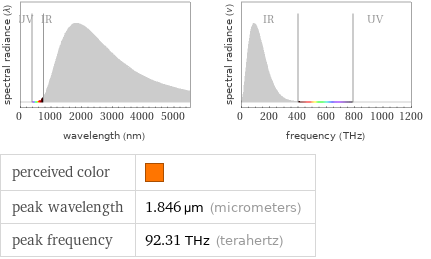Input interpretation

plaster of paris | freezing point
Result

1297 °C (degrees Celsius)
Unit conversions

1570 K (kelvins)

2367 °F (degrees Fahrenheit)

2826 °R (degrees Rankine)

1038 °Ré (degrees Réaumur)

688.4 °Rø (degrees Rømer)
Comparisons as temperature

241 °C below melting point of iron (1538 °C)

100 °C below temperature in the blue part of a candle flame (1670 K)

3 °C below to 597 °C above typical temperature of magma (700 to 1300 °C)
Blackbody information

perceived color | peak wavelength | 1.846 µm (micrometers) peak frequency | 92.31 THz (terahertz)
Corresponding quantities

Thermodynamic energy E from E = kT: | 14 ceV (centielectronvolts)

Blackbody energy flux Φ from Φ = σT^4: | 344648 W/m^2 (watts per square meter)

Approximate luminous exitance from a planar blackbody radiator perpendicular to its surface: | 50243 lx (lux)